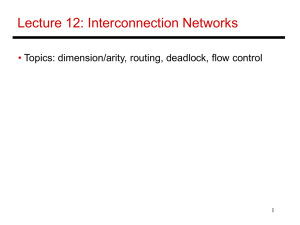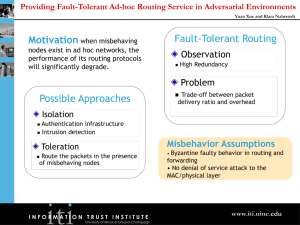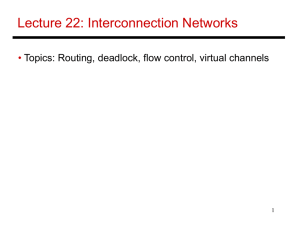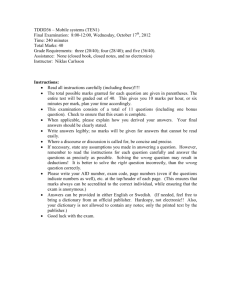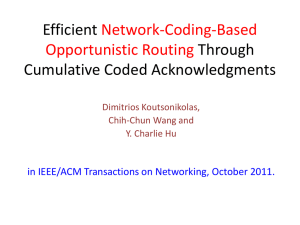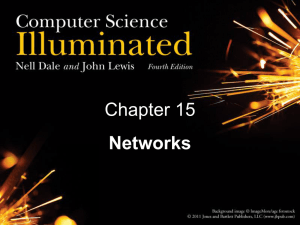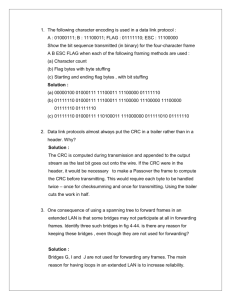Document
advertisement
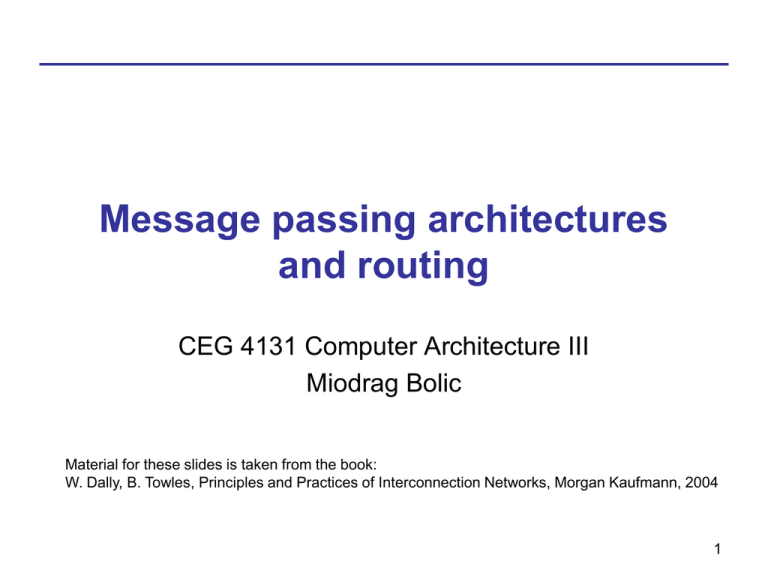
Message passing architectures and routing CEG 4131 Computer Architecture III Miodrag Bolic Material for these slides is taken from the book: W. Dally, B. Towles, Principles and Practices of Interconnection Networks, Morgan Kaufmann, 2004 1 Definitions [1] • A network channel c=(x,y) is characterized by – width wc: the number of parallel signals it contains, – frequency fc: the rate at which bits are transported at each signal – latency tc is the time required for a bit to travel from x to y. • A bandwidth of a channel is W= wc * fc. • The throughput Θ of a network is the data rate in bits per second that network accepts per input port. • Under a particular traffic pattern, the channel that carries the largest fraction of the traffic determines the maximum channel load γ. Load on the channel can be equal or smaller than channel bandwidth. • Θ=W/γ 2 Taxonomy of Routing Algorithms [1] • Deterministic: The simplest algorithm - for each source, destination pair, there is a single path. This routing algorithm usually achieves poor performance because it fails to use alternative routes, and concentrates traffic on only one set of channels. • Oblivious: So named because it ignores the state of the network when determining a path. Unlike deterministic, it considers a set of paths from a source to a destination, and chooses between them. • Adaptive: The routing algorithm changes based on the state of the network. 3 Routing algorithms [1] • Greedy: Always send the packet in the shortest direction around the ring. For example, always route from 0 to 3 in the clockwise direction and from 0 to 5 in the counterclockwise direction. If the distance is the same in both directions, pick a direction randomly. • Uniform random: Randomly pick a direction for each packet, with equal probability of picking either direction. • Weighted random: Randomly pick a direction for each packet, but weight the short direction with probability 1 - Δ /8 and the long direction with Δ/8, where Δ is the (minimum) distance between the source and destination. • Adaptive: Send the packet in the direction for which the local channel has the lowest load. We may approximate load by either measuring the length of the queue serving this channel or recording how many packets it has transmitted over the last T slots. 4 Example [1] • Consider a tornado traffic pattern in which each node i sends a packet to i + 3 mod 8. Which algorithm gives the best worst-case throughput? 5 6 Explanation [1] With the greedy routing algorithm, all of the traffic routes in the clockwise direction around the ring, leaving all of the counterclockwise channels idle and loading the clockwise channels with 3 units of traffic, that is, γ = 3, which gives every terminal a throughput of Θ = W/3. With random routing, the counterclockwise links become the bottleneck with a load of γ = 5/2, since half of the traffic traverses 5 links in the counterclockwise direction. This gives a throughput of 2W/5. Weighting the random decision sends 5/8 of the traffic over 3 links and 3/8 of the traffic over 5 links for a load of γ = 15/8 in both directions giving a throughput of 8W/15. Adaptive routing, with some assumptions on how the adaptivity is implemented, will match this perfect load balance in the steady state, giving the same throughput as weighted random routing. 7 Message Formats [2] • Message: logical unit for internode communication • Packet: basic unit containing destination address for routing • Packets have sequencing # for reassembly • Flits: flow control digits of packets • Store-and-forward: packets • Wormhole routing: flits 8 Packets and Flits [2] • Header flits contain routing information and sequence number • Flit length affected by network size • Packet length determined by routing scheme and network implementation • Lengths also dependent on channel b/w, router design, network traffic, etc. 9 Message Format [2] 10 Latency Analysis [2] • • • • • • L=packet length W=channel b/w (bits/s) D=distance F=flit length TSF=(D + 1)L/W TWH=L/W + D*F/W Store-and-forward: controlled by s/w Wormhole: controlled by h/w 11 12


